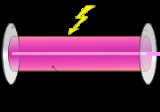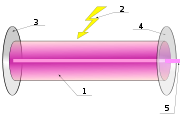
Output coupler
Encyclopedia

Mirror
A mirror is an object that reflects light or sound in a way that preserves much of its original quality prior to its contact with the mirror. Some mirrors also filter out some wavelengths, while preserving other wavelengths in the reflection...
used in laser
Laser
A laser is a device that emits light through a process of optical amplification based on the stimulated emission of photons. The term "laser" originated as an acronym for Light Amplification by Stimulated Emission of Radiation...
s to extract a portion of the laser beam from the optical resonator.
Lasers operate by reflecting
Reflection (physics)
Reflection is the change in direction of a wavefront at an interface between two differentmedia so that the wavefront returns into the medium from which it originated. Common examples include the reflection of light, sound and water waves...
light
Light
Light or visible light is electromagnetic radiation that is visible to the human eye, and is responsible for the sense of sight. Visible light has wavelength in a range from about 380 nanometres to about 740 nm, with a frequency range of about 405 THz to 790 THz...
between two or more mirrors which have an active laser medium
Active laser medium
The active laser medium is the source of optical gain within a laser. The gain results from the stimulated emission of electronic or molecular transitions to a lower energy state from a higher energy state...
between them. The medium amplifies the light by stimulated emission
Stimulated emission
In optics, stimulated emission is the process by which an atomic electron interacting with an electromagnetic wave of a certain frequency may drop to a lower energy level, transferring its energy to that field. A photon created in this manner has the same phase, frequency, polarization, and...
. For lasing to occur, the gain
Gain
In electronics, gain is a measure of the ability of a circuit to increase the power or amplitude of a signal from the input to the output. It is usually defined as the mean ratio of the signal output of a system to the signal input of the same system. It may also be defined on a logarithmic scale,...
of the active medium must be larger than the total loss, which includes both unwanted effects such as absorption
Absorption (electromagnetic radiation)
In physics, absorption of electromagnetic radiation is the way by which the energy of a photon is taken up by matter, typically the electrons of an atom. Thus, the electromagnetic energy is transformed to other forms of energy for example, to heat. The absorption of light during wave propagation is...
, and the intentional release of energy through the output coupler. In other words the laser must attain threshold
Lasing threshold
The lasing threshold is the lowest excitation level at which a laser's output is dominated by stimulated emission rather than by spontaneous emission. Below the threshold, the laser's output power rises slowly with increasing excitation. Above threshold, the slope of power vs. excitation is orders...
.
There are two important properties of the output coupler:
- Radii of curvature
- The output coupler may be either flat or curvedCurved mirrorA curved mirror is a mirror with a curved reflective surface, which may be either convex or concave . Most curved mirrors have surfaces that are shaped like part of a sphere, but other shapes are sometimes used in optical devices...
, depending on the design of the optical cavity. The face of the output coupler facing into the cavity is the side with the applied partially-reflective coating. This is the side which partially determines the laser modal properties. If this inner surface is curved then so must be the outer surface. This will stop the OC performing as a lens. The curvature of the outer surface can be designed to give a collimated laser output. This outer surface generally has an anti-reflection coating applied to maximise the output power.- Reflectivity
- Depending on the gain of the medium, the amount of light the OC needs to reflect back can vary widely. Helium-neon laserHelium-neon laserA helium–neon laser or HeNe laser, is a type of gas laser whose gain medium consists of a mixture of helium and neon inside of a small bore capillary tube, usually excited by a DC electrical discharge.- History of HeNe laser development:...
s require around a 99% reflective mirror to lase, while nitrogen laserNitrogen laserA nitrogen laser is a gas laser operating in the ultraviolet range using molecular nitrogen as its gain medium, pumped by an electrical discharge....
s have an extremely high gain (they are "superradiant") and do not require any OC (0% reflective). The reflectivity of any OC will vary with wavelengthWavelengthIn physics, the wavelength of a sinusoidal wave is the spatial period of the wave—the distance over which the wave's shape repeats.It is usually determined by considering the distance between consecutive corresponding points of the same phase, such as crests, troughs, or zero crossings, and is a...
. A particular mirror may have a tuning range as low as a 10nm or so. For this reason the spectral properties of the OC are important to consider when a laser cavity is being assembled.

